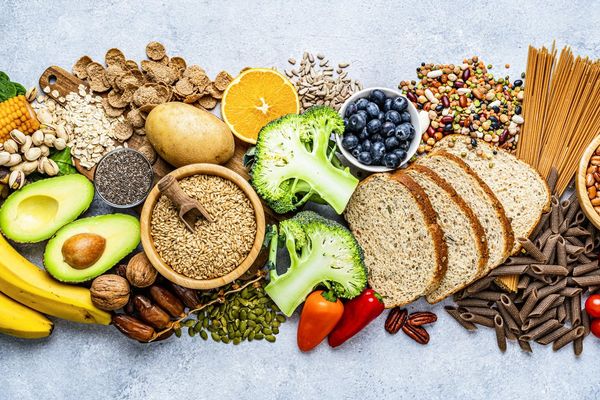Have you heard the term CSA but don't know much about it? Or do you want to learn more before you commit to one?
First things first: CSA stands for community-supported agriculture. Here, a farm offers a certain number of "shares"—a membership or a subscription—to the public. You pay in advance for your share in the seasonal harvest of this local farm or group of farms.
In return, you get a box, bag or basket of produce throughout the farming season. Some CSAs allow you to pick and choose from the farm's bounty. In others, each shareholder gets the same box.
Typically, you'll get vegetables. (Find out if they provide fruit and check out these fruits for weight loss.) But you may also receive farm products like eggs, chicken, pork, homemade bread, fruit, cheese, milk or flowers. You pick up the food at locations around the community, such as schools, parks or farmers markets.
With a CSA membership, you'll get fresh farm-to-table food that's harvested just before pickup. It hasn't sat around grocery stores or in market bins. Because the produce is getting to you right away, it's picked when it's ripe and at peak flavor. And it often costs less than produce in a supermarket.
It's important to note that you typically pay upfront for the whole season. Farmers do their best to offer a plentiful box of produce each week. But sometimes pickings are slim. Maybe there was a drought. The farm may have suffered a tomato blight. Or a storm could have wiped out all the peppers. Perhaps the farm's owner experiences a personal crisis. In cases like these, you likely won't be reimbursed for a less than stellar box. You may wish there were more cucumbers, but you're beholden to whatever offerings the farm sets aside for your shares.
Then, you'll have to come up with ways to use that food. For example, you might try this asparagus with gremolata sauce if you have some asparagus to play with. Or use veggies like carrots and zucchini in this soup. Or make a caprese salad with your tomatoes. Need help getting your kids on board? Try these ways you can get your kids to eat vegetables.
And of course, you may not always get the typical carrots and tomatoes. Instead, you may get some produce you never knew existed or that you've never seen in your grocery store. So, you'll get exposed to new veggies and have to take advantage of them. You'll be forced to get creative and experimental in the kitchen, trying different recipes. Who knows? A food you might never have even heard of may become a new family favorite.
"My favorite surprise was celery root," says Jaime Blanda, 29, who lives in New York City and has been part of a CSA. "It was amazing when you put it in mashed potatoes."
A heads-up that if you don't eat your veggies quickly, you'll be overflowing with produce when you pick up your stash next week. So, some may go to waste. That's why joining a CSA is a commitment to cooking.
On the flip side, depending on the size of your family and how much you cook, you'll likely need to supplement your CSA supplies with fruits and staples like onions, garlic or carrots.
Being a creative cook and eating seasonally may not be for everyone. Many farms provide a list of what produce you can expect and when you can expect it.
"When I would pick up my box, I'd always hear someone say, 'What is this and what do I do with it?'" Blanda recalls. "My answer was always jokingly to 'sauté it with garlic and olive oil.'"
If you eat out a lot, CSA may not be for you because you won't be home to eat what you've bought. Want to get around this challenge? Split a share with a friend and alternate weeks for pick up. That's also a good option if you know you can't make every pickup. You don't usually get a refund if you don't pick up, such as if you're on vacation.
Another solution is to get a juicer to quickly take advantage of all your veggies. Or entertain more or share your bounty with colleagues or learn the art of prepping meals or ingredients in advance. "There's always something in the freezer to look forward to," says Blanda.
CSAs help small farms stay in business. You're supporting your local agriculture directly, not through a retailer. You're reducing the number of miles your food travels from the farm to your plate.
Yes, you support the farm when you shop at the farm itself or purchase their goods at a farmer's market. But, if that farm in town operates a CSA and you don't want it to shut down, consider becoming a shareholder. Thanks to a CSA, the farm gets money early in the season, which helps with their cash flow and ensures them sales throughout the season. And that helps their financial security, which can be fragile and vulnerable to factors beyond their control, such as weather.
Sometimes CSAs require shareholders to pitch in by doing a volunteer shift or two to help lower the administrative cost of the CSA for everyone. (And because CSAs are community-run, you may experience issues like someone not showing up for a shift.) You may be asked to organize a group potluck or solicited for suggestions to improve pickup.
Many CSAs also host a trip to visit their farm and its staff. The farmers get to connect with people like you who are eating what they're growing.
If you want to be active in a good food cause and meet new people at pickup time, a CSA may be for you. But if you're strapped on time, a CSA can be burdensome.
Without a doubt, if you join a CSA, you're contributing to healthy eating for you and your family. You're exposing everyone to a variety of regional produce. And you're supporting a local business, too. For more healthy recipes, check out our recipe section. And read about how to eat healthy on a budget.







